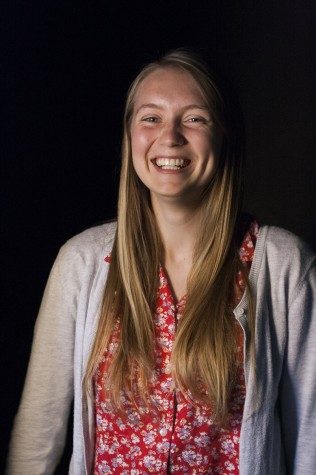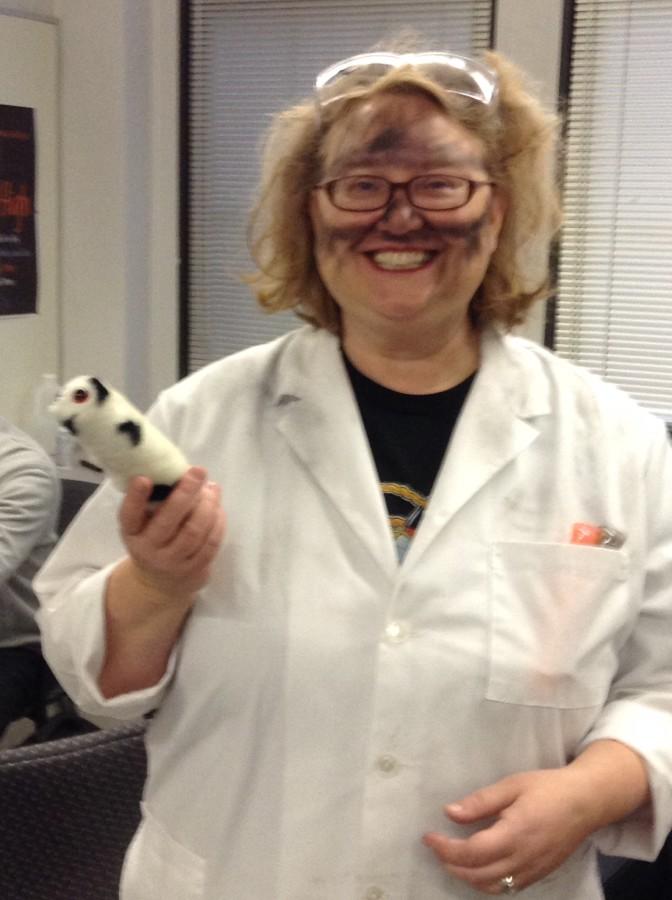New Faces in FOS
David Caine owns no purple shirts. “There were 14 years of purging that color,” said Caine, who in the fall came from Huron to take over FOS 4. And while it was an adjustment to get used to everything from casual violet to Pioneer athletic gear after years of green and gold, the curriculum switch from teaching AP and regular physics to teaching FOS physics was less significant. “It’s physics and trying to get ready for prepared for university-level physics,” Caine said.
Caine’s favorite part of teaching science is clearing up misconceptions. “All of my graduate work when I was getting certified initially to become a teacher was in misconceptions,” Caine said. “I find that to be the most fun thing about teaching is having students realize a misconception they have and then helping them figure out a way around it.”
Caine replaced Rosi Simmer, who left to spend more time with her family, as a long-term sub for the duration of the first semester. For second semester and beyond, the standard hiring process is occurring. Details on a decision have yet to become clear.
Seniors are not the only class with new a new face; Christia West joined the FOS department this year teaching two sections of FOS 1. West, a Michigan native, has always loved science but took a long voyage to find teaching.
“I have a business degree and I was a capital acquisitions buyer with Nissan in the industry but it wasn’t intellectually challenging enough,” West said. “ I went back to school and I wasn’t sure what I wanted to do in science but I really loved it… I ended up actually doing massage therapy.”
In massage therapy school, West was tracked as a teaching assistant and eventually had her own classes in massage technique, pathology and anatomy and physiology. “It was applied science,” West said. “A lot of people think of massage and think it’s touchy feely. But the type of massage at our school was very clinically based.”
In her 15 years of teaching, West taught massage-based injury prevention and recovery to students of all ages. Some came to her classes straight out of high school, others were nurses. A doctor once took her weekend workshop. It was a math teacher in a class once who first suggested that West think about teaching high school. Though she initially dismissed the idea, a year later, West went back to school again, this time to get her teaching certificate. She now teaches at both Community and Skyline and is loving it.
“The biggest reward is seeing students grow,” West said. “If I have a student who thinks they can’t get it then just seeing that when they realize ‘oh yeah, I can do this,’ that is the best thing ever.”
In the future, West is working on incorporating more technology into her teaching. “I like to use technology a lot… I’m trying to add more online tools that students can use for studying and I have a YouTube channel that I have some ideas for,” West said. “I’m also really interested in creating a virtual classroom space… Google is developing a program called Classroom that’s still in beta right now and I’d love to look at using that.”
Like West, Courtney Kiley didn’t come straight to teaching after college. “I was a fisheries biologist before I became a teacher and biology and ecology are really my passions,” said Kiley. I’ve been waiting to teach an ecology class for seven years.” This year, it happened.
During first semester, Kiley taught Community’s first Ecology class, a scheduling spot that second semester will be filled by a new Forensics class taught by Liz Stern. “We wanted to offer something that a senior could take instead of Physics,” Kiley said.
Ecology is structured around studying the five ecoregions, environmental categorizations defined by distinct geography and climate, of Michigan: forest, fluvial, wetlands, the Great Lakes and urban ecology. Each unit involved guest speakers and field trips, connecting lectures to real-world practices in conservation and resource management. Plans for second semester Forensics involve fetal pigs and a staged murder scene reminiscent of the investigation previously a part of FOS 3.
“That’s taken out of FOS 3 now and put in [Forensics] because they felt that there wasn’t enough time to cover the chemistry they wanted in FOS 3,” Kiley said. “We’ve also gotten rid of the FOS 1 paper maché glacier project. Everyone’s so upset about losing that… so we’re expanding this urban design project and talking about hydrogen fuel cell cars. We’re trimming down the glacier project and beefing up technology and relevant topics. Instead of learning about Michigan’s past, we’re moving to the future.”
In the years to come, Kiley has big plans. After growing FOS 4 into a three-section class over the past years, she hopes to develop one as calculus-based for students who want the extra challenge. Ecology and Forensics both have the potential to become full-year classes. “Seeing the program grow and incorporating technology and… the arts,” Kiley said. “Seeing that stuff happen would be really cool.”










